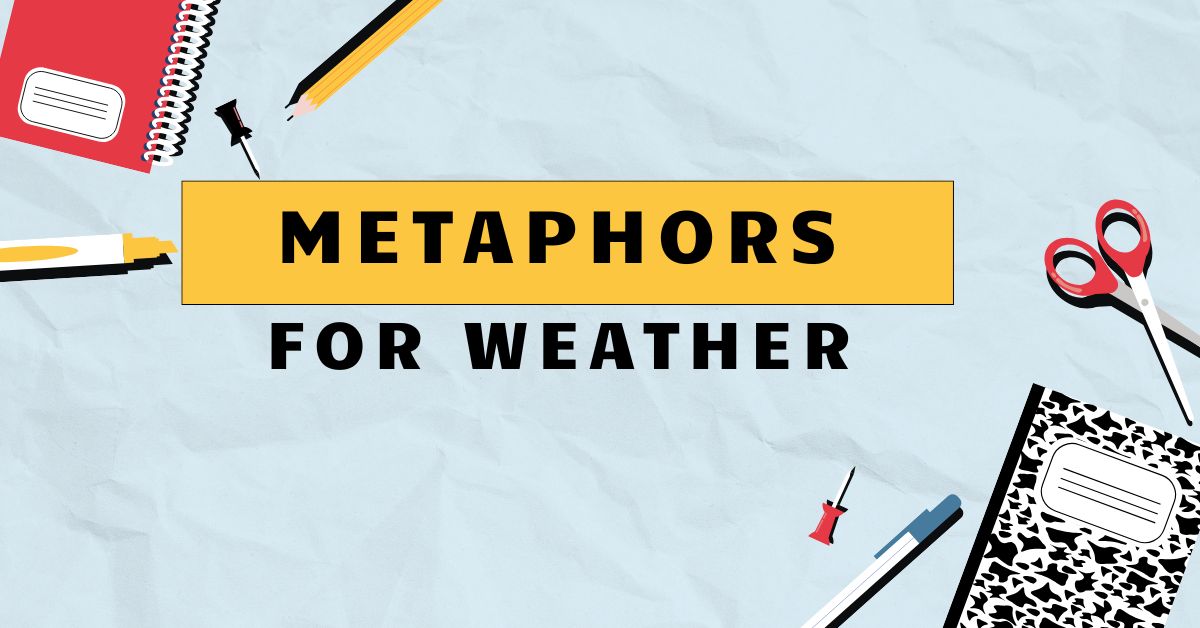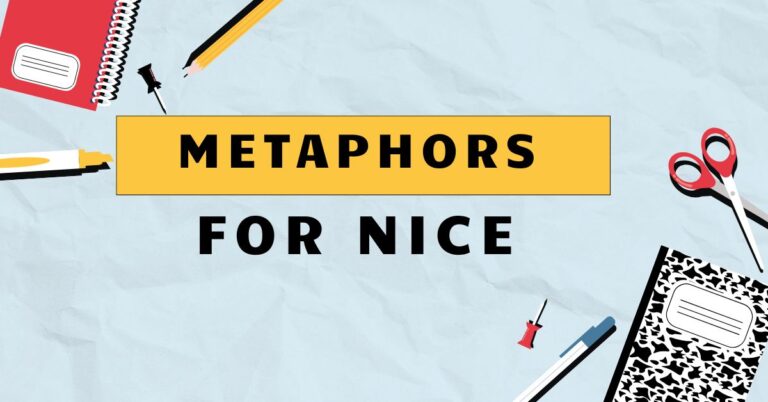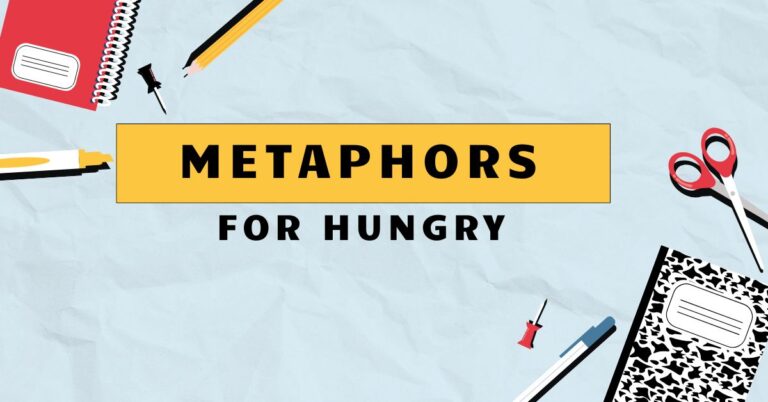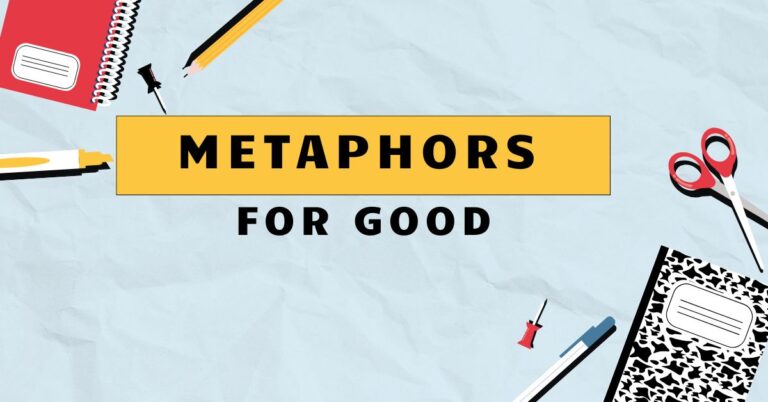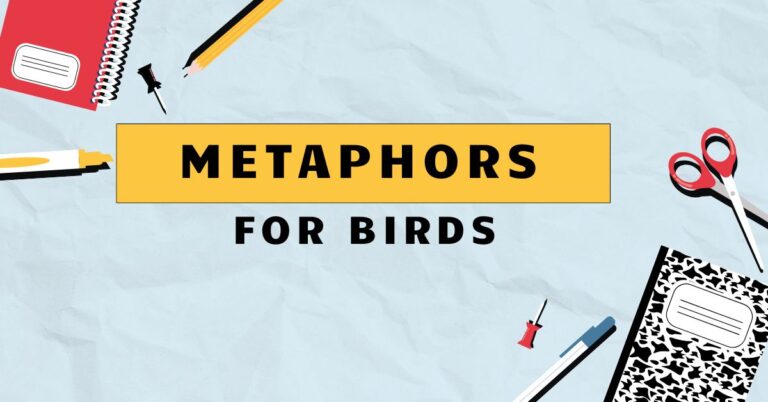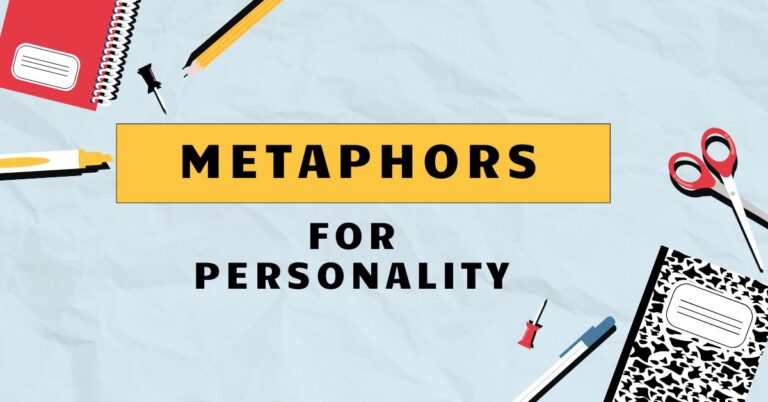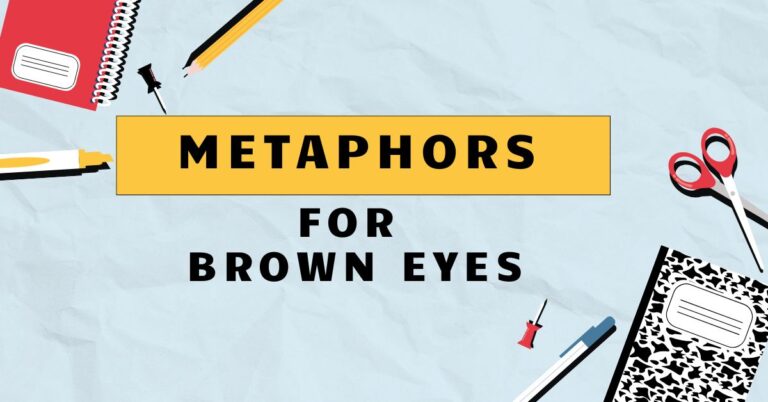35 Weather Metaphors: Mastering Figurative Language in English
Understanding metaphors is crucial for grasping the nuances of the English language. Metaphors, in general, allow us to understand abstract concepts by relating them to more concrete, familiar experiences.
When applied to weather, these comparisons create vivid imagery and add depth to our communication. This article explores the fascinating world of weather metaphors, providing a comprehensive guide for English language learners and enthusiasts alike.
By delving into the definitions, structures, types, and usage rules of weather metaphors, you’ll enhance your comprehension and expressive abilities, making your language more colorful and impactful. Whether you’re a student, writer, or simply someone looking to improve their English skills, this article will equip you with the knowledge and tools to master weather metaphors.
This article provides detailed explanations, numerous examples, and practical exercises. By exploring the structural breakdown of weather metaphors, their different types, and common usage rules, you will gain a solid understanding of this essential aspect of English grammar.
The extensive examples and practice exercises will allow you to apply your knowledge and improve your skills effectively. Ready to transform your understanding of language?
Let’s begin!
Table of Contents
- Introduction
- Definition of Weather Metaphors
- Structural Breakdown
- Types of Weather Metaphors
- Examples of Weather Metaphors
- Usage Rules
- Common Mistakes
- Practice Exercises
- Advanced Topics
- FAQ
- Conclusion
Definition of Weather Metaphors
To fully understand weather metaphors, it’s essential to first grasp the general concept of a metaphor. Then, we can delve into the specific characteristics and applications of weather metaphors.
What is a Metaphor?
A metaphor is a figure of speech that directly compares two unrelated things without using “like” or “as.” It asserts that one thing *is* another, creating a vivid and often surprising connection. This comparison isn’t literal but rather suggests a similarity in qualities or characteristics.
The purpose of a metaphor is to enhance understanding, evoke emotion, or add stylistic flair to writing and speech.
For example, saying “Time is a thief” doesn’t mean time literally steals things. Instead, it means time passes quickly and takes away our youth, opportunities, and memories, much like a thief steals valuables.
Defining Weather Metaphors
Weather metaphors specifically use weather elements – such as rain, sunshine, storms, and fog – to describe non-weather-related concepts. These metaphors draw parallels between the characteristics of weather and human emotions, situations, or personal traits.
By employing weather imagery, these metaphors can paint a more vivid and relatable picture for the audience.
Consider the phrase “She’s a ray of sunshine.” This metaphor doesn’t mean the person literally emits light. Instead, it suggests that she is cheerful, positive, and brings joy to those around her, just as sunshine brightens a gloomy day.
Function of Weather Metaphors
Weather metaphors serve multiple functions in communication. Primarily, they add color and depth to language, making it more engaging and memorable.
They can also simplify complex emotions or situations by relating them to familiar weather patterns. Furthermore, these metaphors can evoke specific moods or feelings in the audience, enhancing the overall impact of the message.
For instance, describing a difficult period as “a stormy phase” immediately conveys the idea of turbulence, hardship, and emotional upheaval. This is far more evocative than simply saying “it was a difficult time.”
Contexts of Use
Weather metaphors are versatile and can be used in various contexts, including literature, everyday conversation, journalism, and even business communication. In literature, they add layers of meaning and symbolism to narratives and poetry.
In everyday conversation, they help express feelings and ideas in a more relatable way. In journalism, they can create impactful headlines and descriptions.
Even in business, they can be used to describe market trends or company performance.
Imagine a news headline that reads, “Economic Forecast: Cloudy with a Chance of Recession.” This metaphor immediately conveys a sense of uncertainty and potential downturn in the economy, capturing the reader’s attention more effectively than a straightforward statement.
Structural Breakdown
Understanding the structure of a weather metaphor involves recognizing the source domain (weather), the target domain (the concept being described), and the implicit comparison that links them.
Source Domain: Weather
The source domain is the weather element itself – the literal aspect of the metaphor. This includes specific weather conditions such as rain, snow, sunshine, storms, fog, and wind.
Each of these elements carries its own set of associations and connotations that contribute to the overall meaning of the metaphor.
For example, “rain” often symbolizes sadness, cleansing, or renewal, while “sunshine” typically represents happiness, warmth, and positivity. The choice of weather element significantly influences the message being conveyed.
Target Domain: Abstract Concepts
The target domain is the abstract concept, emotion, situation, or personal trait being described using the weather element. This could be anything from a person’s mood to the state of a relationship or the progress of a project.
The metaphor works by transferring the characteristics of the weather element to this target domain.
When we say “Their relationship is going through a cold spell,” the target domain is the relationship, and the “cold spell” (the source domain) suggests a period of emotional distance or lack of affection.
Linking Mechanism: Implicit Comparison
The linking mechanism is the implicit comparison between the source and target domains. This comparison is not explicitly stated but rather implied through the use of the weather element.
The audience must understand the shared characteristics or associations between the two domains to grasp the meaning of the metaphor.
In the metaphor “He weathered the storm,” the implicit comparison is between a difficult life situation and a literal storm. The metaphor suggests that he successfully endured and overcame the challenges, just as someone would survive a storm.
Types of Weather Metaphors
Weather metaphors can be categorized based on the types of concepts they describe. The most common categories include emotional weather, situational weather, and personal weather.
Emotional Weather
Emotional weather metaphors use weather elements to describe a person’s feelings or emotional state. These metaphors are particularly effective in conveying the intensity and variability of emotions.
They allow us to express feelings in a more vivid and relatable way.
Examples include: “She was a hurricane of emotion,” “He felt a cloud of sadness hanging over him,” and “Her anger was a sudden burst of thunder.”
Situational Weather
Situational weather metaphors describe the state or condition of a particular situation or event. These metaphors help to characterize the atmosphere, progress, or challenges associated with a given scenario.
They provide a concise and evocative way to convey the nature of a situation.
Examples include: “The project is in a fog,” “The market is experiencing a heatwave,” and “The negotiations hit an icy patch.”
Personal Weather
Personal weather metaphors describe a person’s character, personality, or general disposition using weather elements. These metaphors offer insights into someone’s overall demeanor and the kind of impact they have on others.
They provide a metaphorical “weather report” of a person’s being.
Examples include: “He’s a ray of sunshine,” “She has a stormy temperament,” and “He’s a gentle breeze.”
Examples of Weather Metaphors
To solidify your understanding, let’s examine various examples of weather metaphors categorized by emotional, situational, and personal applications. Each table provides a diverse range of examples to illustrate the versatility of these metaphors.
Emotional Weather Examples
The following table showcases how weather elements can be used to describe different emotional states. Notice how each weather condition evokes a specific feeling or mood.
| Metaphor | Meaning |
|---|---|
| She was a hurricane of emotion. | She was overwhelmed with intense and chaotic feelings. |
| He felt a cloud of sadness hanging over him. | He was experiencing a persistent feeling of sorrow or depression. |
| Her anger was a sudden burst of thunder. | She expressed her anger explosively and unexpectedly. |
| Tears streamed down her face like a summer rain. | She cried heavily and uncontrollably. |
| His joy was as bright as the morning sun. | He felt intense happiness and positivity. |
| A wave of despair washed over him. | He was suddenly overcome with a feeling of hopelessness. |
| She felt a gentle breeze of contentment. | She experienced a subtle and peaceful sense of satisfaction. |
| His heart was frozen with fear. | He was paralyzed by intense fear. |
| A storm of anxiety raged within her. | She was experiencing intense and overwhelming anxiety. |
| He was shrouded in a fog of confusion. | He was feeling disoriented and unable to think clearly. |
| Her laughter was like a refreshing rain after a long drought. | Her laughter was revitalizing and brought relief. |
| He felt a chill of loneliness. | He experienced a cold and isolating feeling. |
| Her hope was a tiny spark in the darkness. | She had a small but persistent feeling of optimism. |
| He was swept away by a whirlwind of passion. | He was intensely consumed by strong emotions. |
| Her silence was a heavy snow, blanketing the room. | Her silence created a stifling and oppressive atmosphere. |
| He felt the warm sunshine of her smile. | Her smile made him feel happy and comforted. |
| A drizzle of doubt dampened his enthusiasm. | A small amount of doubt lessened his excitement. |
| She unleashed a torrent of accusations. | She released a flood of angry statements. |
| His love for her was a constant, unwavering sun. | His love was consistent and reliable. |
| The news hit him like a bolt of lightning. | The news shocked and surprised him. |
| His anger simmered like a brewing storm. | His anger was building up gradually. |
| She was a rainbow after a storm, promising better days. | She brought hope and positivity after a difficult period. |
| He felt the icy grip of despair tightening around him. | He was increasingly consumed by feelings of hopelessness. |
| Her words were a gentle rain, soothing his troubled mind. | Her words were calming and comforting. |
| He felt the weight of the world like a perpetual downpour. | He felt constantly burdened by his responsibilities. |
| Her optimism shone like a beacon through the fog of uncertainty. | Her positivity provided guidance and clarity. |
| He was caught in a blizzard of conflicting emotions. | He was overwhelmed by a chaotic mixture of feelings. |
Situational Weather Examples
This table illustrates how weather metaphors can describe different kinds of situations or events, capturing their atmosphere and progress.
| Metaphor | Meaning |
|---|---|
| The project is in a fog. | The project lacks clarity and direction. |
| The market is experiencing a heatwave. | The market is performing exceptionally well and growing rapidly. |
| The negotiations hit an icy patch. | The negotiations encountered a difficult and tense phase. |
| The company is weathering the storm. | The company is enduring a period of hardship and challenge. |
| The political climate is stormy. | The political situation is turbulent and unstable. |
| The economy is experiencing a cold snap. | The economy is undergoing a sudden and temporary downturn. |
| The industry is facing a drought of innovation. | The industry is lacking new ideas and developments. |
| The team is enjoying a period of sunshine. | The team is experiencing success and positive outcomes. |
| The merger is clouded with uncertainty. | The outcome of the merger is unclear and unpredictable. |
| The competition is heating up. | The level of competition is increasing significantly. |
| The situation is as clear as a sunny day. | The situation is easily understood and straightforward. |
| The business is in a whirlwind of activity. | The business is experiencing a period of intense and rapid activity. |
| The peace talks are frozen. | The peace talks have stalled and are not progressing. |
| The project is blossoming like a spring flower. | The project is developing and flourishing successfully. |
| The atmosphere was electric, a storm brewing beneath the surface. | The tension was palpable, suggesting an imminent conflict. |
| The campaign gained momentum like a snowball rolling downhill. | The campaign rapidly increased in popularity and support. |
| The market was flooded with new products. | An excessive amount of new products were introduced to the market. |
| The scandal cast a long shadow over the company. | The scandal negatively impacted the company’s reputation. |
| The deal went through like a breeze. | The deal was completed quickly and easily. |
| The new policy was met with a hailstorm of criticism. | The new policy received a barrage of negative feedback. |
| The industry is navigating uncharted waters. | The industry is facing new and unfamiliar challenges. |
| The project’s progress was hampered by a persistent drizzle of setbacks. | The project experienced continuous minor obstacles. |
| The company is bracing for a severe economic winter. | The company is preparing for a period of financial hardship. |
| The conference was a breath of fresh air. | The conference was stimulating and revitalizing. |
| The technology sector is currently experiencing a golden age. | The technology sector is thriving and prosperous. |
| The investigation uncovered a murky swamp of corruption. | The investigation revealed a complex and difficult situation. |
| The reforms sparked a wildfire of social change. | The reforms initiated rapid and widespread social transformations. |
Personal Weather Examples
This table provides examples of how weather can be used to describe a person’s character, personality, or disposition.
| Metaphor | Meaning |
|---|---|
| He’s a ray of sunshine. | He is cheerful, positive, and brings joy to others. |
| She has a stormy temperament. | She is prone to sudden outbursts of anger or frustration. |
| He’s a gentle breeze. | He is calm, soothing, and easy to be around. |
| She’s a force of nature. | She is powerful, dynamic, and has a strong influence. |
| He’s a cold fish. | He is unemotional, aloof, and distant. |
| She’s a breath of fresh air. | She is refreshing, innovative, and brings new perspectives. |
| He’s a dark cloud. | He is pessimistic, gloomy, and brings negativity. |
| She’s a whirlwind of energy. | She is dynamic, active, and full of enthusiasm. |
| He’s a solid rock. | He is reliable, dependable, and steadfast. |
| She’s an icy queen. | She is cold, distant, and unapproachable. |
| He’s a summer breeze, always warm and welcoming. | He is consistently friendly and inviting. |
| She’s a thunderclap, commanding attention with her presence. | She is striking and impactful, easily capturing attention. |
| He’s a calming rain, bringing peace to those around him. | He is soothing and brings tranquility to others. |
| She’s a snowstorm, leaving a lasting impression wherever she goes. | She is memorable and impactful, making a significant impression. |
| He is a gentle snowflake, unique and delicate. | He is special and sensitive. |
| She’s a beacon of light in a dark world. | She provides guidance and hope to others. |
| He’s a walking thunderstorm, always ready to explode. | He is easily provoked and prone to anger. |
| She’s a cool breeze on a hot day. | She is refreshing and provides relief. |
| He’s a dense fog, difficult to understand. | He is confusing and hard to comprehend. |
| She is the eye of the storm, a place of calm amidst chaos. | She is composed and centered amidst turmoil. |
| He’s a sunny disposition, always looking on the bright side. | He is consistently optimistic and positive. |
| She’s a fierce wind, pushing others to achieve their best. | She is motivating and encourages others to succeed. |
| He’s an unpredictable downpour, full of surprises. | He is often unexpected and full of surprises. |
| She’s a radiant sunrise, full of promise and new beginnings. | She is hopeful and signifies new opportunities. |
| He’s a gathering storm, hinting at hidden depths. | He has complexities and secrets beneath the surface. |
| She’s a refreshing spring shower, invigorating and renewing. | She revitalizes and brings new energy. |
| He’s a looming dark cloud, always expecting the worst. | He is pessimistic and anticipates negative outcomes. |
Usage Rules
Using weather metaphors effectively requires understanding certain rules and guidelines. These rules ensure that your metaphors are appropriate, consistent, and culturally sensitive.
Appropriateness and Context
Ensure that the weather metaphor is appropriate for the context and audience. Consider the tone and formality of the situation.
A casual conversation might allow for more creative and whimsical metaphors, while a formal presentation may require more serious and straightforward language.
For example, describing a business deal as “a walk in the park” might be suitable in a casual conversation among colleagues, but it would be inappropriate in a formal report to investors.
Consistency in Metaphorical Language
Maintain consistency in your metaphorical language. Avoid mixing metaphors that create conflicting images or undermine the overall message.
If you start with a weather metaphor, try to continue with related imagery throughout the passage.
For example, if you describe a project as being “in a fog,” it would be inconsistent to then say that it’s “sailing smoothly.” The fog suggests confusion and lack of clarity, while sailing smoothly implies progress and ease.
Cultural Considerations
Be mindful of cultural differences in the interpretation of weather symbols. Certain weather conditions may have different connotations in different cultures.
What is considered positive in one culture may be negative in another. Understanding these nuances can help you avoid miscommunication and cultural insensitivity.
For example, while rain might be seen as cleansing and refreshing in some cultures, it could be associated with sadness and mourning in others. Therefore, using a rain metaphor to describe a situation requires careful consideration of the cultural context.
Avoiding Clichés
Strive to avoid overused or cliché weather metaphors. While these metaphors may be easily understood, they can also lack originality and impact.
Instead, try to create fresh and imaginative comparisons that capture the audience’s attention.
Instead of saying “He’s a ray of sunshine” (a common cliché), you could say “His presence is like a warm summer breeze on a sweltering day,” which is more descriptive and engaging.
Common Mistakes
Several common mistakes can undermine the effectiveness of weather metaphors. Being aware of these pitfalls can help you avoid them and use metaphors more skillfully.
Mixed Metaphors
Mixed metaphors occur when two or more incompatible metaphors are combined, creating a nonsensical or confusing image. These should be avoided as they diminish clarity and credibility.
Incorrect: “We need to nip it in the bud before it snowballs into a raging inferno.” (Mixing plant growth, snow accumulation, and fire.)
Correct: “We need to address the problem quickly before it escalates out of control.”
Overused Metaphors
Overused metaphors, also known as clichés, have lost their impact due to excessive use. These metaphors often sound unoriginal and fail to capture the audience’s attention.
Overused: “He’s a ray of sunshine.”
Better: “His optimism brightens every room he enters.”
Inappropriate Metaphors
Inappropriate metaphors are those that are unsuitable for the context, audience, or subject matter. These metaphors can be offensive, insensitive, or simply out of place.
Inappropriate: Describing a tragedy as “a walk in the park.”
Appropriate: Describing the same tragedy as “a devastating blow.”
Practice Exercises
To reinforce your understanding of weather metaphors, complete the following exercises. Each exercise focuses on a different aspect of using and identifying weather metaphors.
Exercise 1: Identifying Weather Metaphors
Identify the weather metaphors in the following sentences and explain their meaning.
| Question | Answer |
|---|---|
| 1. The stock market experienced a sudden downpour this week. | The stock market experienced a sudden decline in value. “Downpour” is the metaphor. |
| 2. Her words were a gentle rain, soothing his troubled mind. | Her words were calming and comforting. “Gentle rain” is the metaphor. |
| 3. He weathered the storm of criticism with grace. | He endured and overcame the criticism. “Weathered the storm” is the metaphor. |
| 4. The project is shrouded in a fog of uncertainty. | The project lacks clarity and direction. “Shrouded in a fog” is the metaphor. |
| 5. Their relationship is going through a cold spell. | Their relationship is experiencing a period of emotional distance. “Cold spell” is the metaphor. |
| 6. She’s a whirlwind of energy, always on the go. | She is dynamic, active, and full of enthusiasm. “Whirlwind of energy” is the metaphor. |
| 7. The negotiation process hit an icy patch when they disagreed on the terms. | The negotiation process encountered a difficult and tense phase. “Icy patch” is the metaphor. |
| 8. The company is hoping for clearer skies after a year of financial losses. | The company is hoping for a more positive financial situation after previous losses. “Clearer skies” is the metaphor. |
| 9. He felt the weight of her disappointment like a heavy cloud. | He felt burdened by her disappointment. “Heavy cloud” is the metaphor. |
| 10. Her smile was like a sunrise, warming his heart. | Her smile was uplifting and made him feel happy. “Sunrise” is the metaphor. |
Exercise 2: Creating Weather Metaphors
Create weather metaphors to describe the following situations or emotions.
| Situation/Emotion | Possible Metaphor |
|---|---|
| A feeling of great joy | His joy was as radiant as the midday sun. |
| A difficult challenge | The challenge was a fierce blizzard, testing their resilience. |
| A period of peace and tranquility | The days were a gentle, sunny calm after the storm. |
| A sudden surprise | The news hit him like a bolt from the blue. |
| A state of confusion | He was lost in a thick fog of uncertainty. |
| A strong determination | Her determination was an unyielding wind, pushing her forward. |
| A moment of clarity | Suddenly, everything became as clear as a summer day. |
| A sense of being overwhelmed | He was drowning in a torrential downpour of responsibilities. |
| A feeling of isolation | He felt like a lone tree in a frozen tundra. |
| A burst of creativity | Her mind was ignited by a flash flood of ideas. |
Exercise 3: Correcting Incorrect Metaphors
Identify and correct the mixed or inappropriate metaphors in the following sentences.
| Incorrect Metaphor | Corrected Metaphor |
|---|---|
| 1. We need to nip it in the bud before it snowballs into a raging inferno. | We need to address the problem quickly before it escalates out of control. |
| 2. The project is sailing smoothly, despite the fog. | The project is progressing slowly, due to the fog. |
| 3. He’s a ray of sunshine, but also a cold fish. | He’s a positive influence, but can also be distant. |
| 4. The economy is a rollercoaster of sunshine and storms. | The economy is experiencing alternating periods of prosperity and recession. |
| 5. Her anger was a volcano erupting like a gentle stream. | Her anger was a volcano erupting with fiery intensity. |
| 6. The company needs to weather the storm and grab the bull by the horns. | The company needs to weather the storm and take decisive action. |
| 7. The team is drowning in a sea of success. | The team is enjoying a wave of success. |
| 8. His arguments were as clear as mud on a sunny day. | His arguments were confusing and unclear. |
| 9. She’s a breath of fresh air, but also a dark cloud. | She’s innovative and refreshing, but can also be pessimistic. |
| 10. The negotiations were an uphill battle in a dense fog. | The negotiations were difficult and lacked clarity. |
Advanced Topics
For advanced learners, exploring extended metaphors, dead metaphors, and literary analysis can provide a deeper understanding of weather metaphors.
Extended Metaphors
An extended metaphor is a metaphor that is developed over several lines or even throughout an entire work. It allows for a more complex and nuanced comparison between the source and target domains.
For example, a poem might use the metaphor of a storm to represent a character’s inner turmoil, with each stanza exploring different aspects of the storm and their corresponding emotional states. The storm’s intensity, duration, and eventual clearing could all mirror the character’s journey.
Dead Metaphors
A dead metaphor is a metaphor that has become so common that it is no longer recognized as a figure of speech. Its literal meaning has been lost, and it is used as a standard expression.
Examples include “leg of a table” or “head of a department.” While these phrases originated as metaphors, they are now considered literal terms. Recognizing dead metaphors can help you appreciate the evolution of language.
Literary Analysis of Weather Metaphors
Analyzing weather metaphors in literature involves examining how authors use weather imagery to convey deeper meanings, create atmosphere, and develop themes. This includes identifying the specific weather elements used, their connotations, and their relationship to the text’s overall message.
For example, in Shakespeare’s *King Lear*, the storm serves as a powerful metaphor for Lear’s mental and emotional breakdown, reflecting the chaos and upheaval within him and the kingdom. Analyzing this metaphor reveals deeper insights into the play’s themes of madness, power, and nature.
FAQ
Here are some frequently asked questions about weather metaphors.
- What is the difference between a metaphor and a simile?
A metaphor directly compares two things by stating that one *is* the other, while a simile compares two things using “like” or “as.” For example, “He is a lion” (
metaphor) versus “He is brave as a lion” (simile).
- How can I improve my use of weather metaphors?
Practice identifying and creating weather metaphors, pay attention to context and appropriateness, and avoid clichés. Read widely to expose yourself to different uses of figurative language.
- Are weather metaphors universal?
While some weather metaphors are widely understood, cultural differences can influence their interpretation. Be mindful of these differences when communicating with diverse audiences.
- What should I do if I accidentally use a mixed metaphor?
Recognize the mistake and correct it immediately. Rewrite the sentence or passage to use consistent and coherent imagery.
- How can I make my weather metaphors more original?
Think beyond common associations and explore unique connections between weather elements and the concepts you are describing. Use vivid and descriptive language to create fresh and memorable images.
- How do weather metaphors enhance communication?
Weather metaphors enhance communication by making abstract ideas more relatable and vivid. They add color and depth to language, making it more engaging and memorable for the audience.
- Why are weather metaphors so commonly used?
Weather metaphors are commonly used because weather is a universal experience. Most people can relate to the feelings and imagery associated with different weather conditions, making these metaphors easily understood.
- Can weather metaphors be used in business writing?
Yes, weather metaphors can be used in business writing to describe market trends, company performance, or project progress. However, it’s important to use them judiciously and ensure they are appropriate for the context.
- What is an example of a weather metaphor used in literature?
In Emily Brontë’s “Wuthering Heights,” the wild and stormy weather mirrors the turbulent emotions and relationships of the characters, enhancing the novel’s dramatic and gothic atmosphere.
- How do I avoid using clichés in my writing with weather metaphors?
To avoid using clichés, brainstorm unique and specific qualities of the weather element you’re using and relate them in fresh ways to the concept you’re describing. Originality comes from detailed observation and creative connections.
Conclusion
Mastering weather metaphors can significantly enhance your English language skills, allowing you to express yourself more vividly and effectively. By understanding the structure, types, and usage rules of these metaphors, you can add depth and color to your communication.
Whether you’re writing a novel, giving a presentation, or simply engaging in everyday conversation, weather metaphors can help you connect with your audience on a deeper level.
Continue to practice identifying and creating weather metaphors, and be mindful of the context, audience, and cultural considerations. With dedication and creativity, you can harness the power of weather metaphors to transform your language and captivate your listeners.

